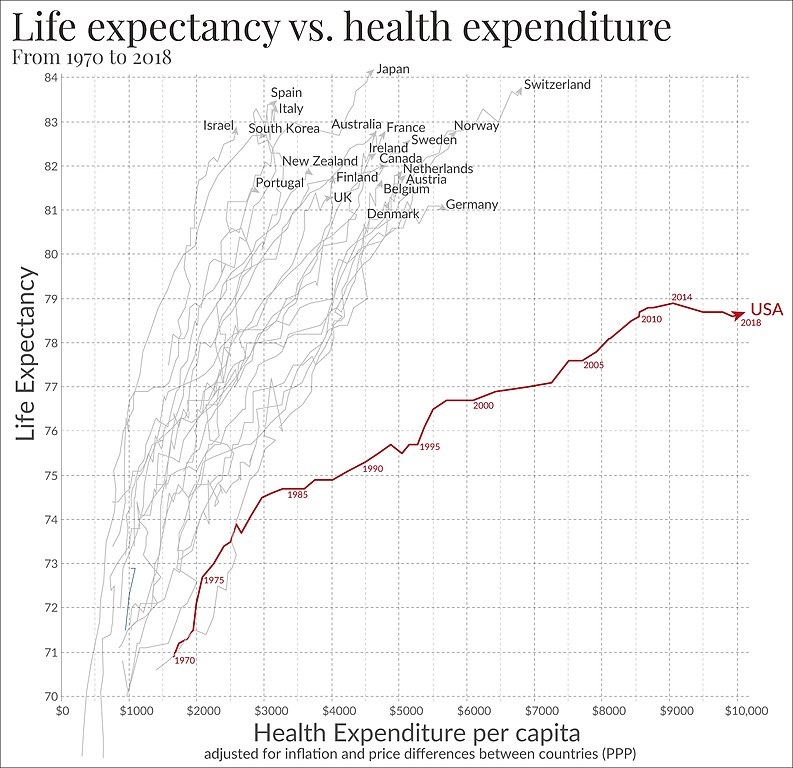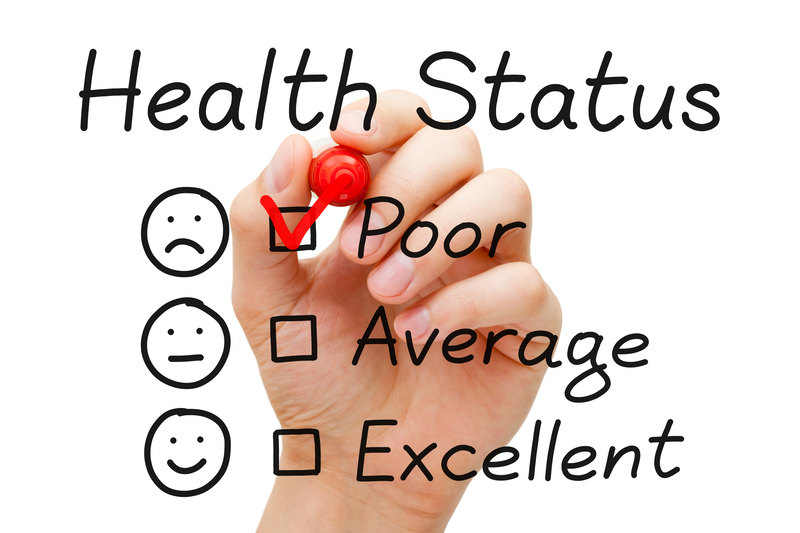The Human View™ Blog

US Healthcare - The Worst System Money Can Buy?
Is the US healthcare system "the worst system money can buy?" The Intellectualist says "yes."
Despite our advanced technology and exemplary facilities, doctors, nurses and staff, it's not news that when it comes to how we finance care, we're plagued by significant inefficiencies and inequities. We're spending about 17% of GDP (about $4.5T out of an estimated 2023 GDP of $26.4T), yet we lag most other developed countries' life expectancy by - a lot!

U.S. life expectancy has dropped
Life expectancy in the U.S. is notably lower than pretty much every other developed country in the world. This is at least partly due to the high prevalence of chronic diseases and the inefficient management of conditions that could be addressed outside hospital settings.
The affordability crisis further complicates matters. Of course the uninsured - but also the insured! - face financial burdens in accessing medical care. This often leads to cost-related non-adherence to medical advice. This, in turn, drives worse short- and long-term health outcomes which, disturbingly, are contributing to increasing "deaths of despair" related to alcohol, drugs, and clinical depression. All of these (potentially avoidable) healthcare challenges continue to deepen and worsen their broader societal impacts.
Social determinants of health
Racial and socioeconomic disparities further compound these dynamics. Black and Hispanic adults, particularly those with lower incomes, are more likely to skip necessary healthcare due to costs. This results not only in economic hardship, but also in generational health issues, reduced national productivity, and weakened social and workplace cohesion.
But wait! - it gets even more complicated! The opioid crisis is yet another factor in the broader systemic failures of healthcare and related societal structures. Overprescribing and a huge black market are just some of the artifacts of the complex interplay between healthcare policies and related socio-economic factors.

So, if we're really committed to improving health outcomes, we have to pursue a multi-pronged strategy. While employer health improvement efforts have been routinely thwarted by low engagement, employers can't directly define the needed national healthcare policy reforms, nor directly affect the broader economic and social determinants of health. But they can help employees develop better personal benefit portfolios that put cash in their pockets via robust voluntary benefit offerings.
Message in a bottle
Next, employer-sponsored cost mitigation programs like disease management, mental & emotional health support, point solutions, cost and quality transparency tools, and navigation and employee advocacy programs can all play pivotal roles. But we've simply got to get more employees to enroll in and use these voluntary plans!
Before claims analytics, we were all stymied in trying to contain costs because we didn't know the specifics of what was driving the cost increases. Now, we have no doubt: low patient / employee activation and engagement are driving fragmented and incomplete care. Plus, employees are changing jobs more often, leading to even greater care discontinuity and mediocre outcomes, which further exacerbate our costs.

Let's face it, "benefit communications" just haven't gotten us to where we want to be. And it's not really anybody's fault - but they've been about as effective as sending a message in a bottle.
Going back to what I've written before, how many times have you heard one of your HR or Benefit clients say, "If we could just do a better job of educating our people, they'd make better decisions!" And that's true, right up until we hit - again - our upper limit problem. Even if we have 50% engagement (rare!), 60% would be even better, no?
Here's the good news - "weak links are also maximum leverage points."
Engagement is the keystone
Encouraging employees to enroll and engage in employer-sponsored cost mitigation programs is vital. But we have to do more than just educate - we have to motivate. The benefitpersonas™ model does this by making Values-Based Communications™ possible. These psychographic "infusions" consistently and predictably increase the “Want-To Factor.”
By supplying individual-level data elements to categorize employees, and developing personalized messaging based on the values and world views of each persona type, we increase the chances of achieving the critical mass necessary for long-term cost reduction:
39% response rate for personalized messaging vs. 27% for "one-size-fits-all" messaging for a colon cancer screening campaign
33% more counselor appointments than expected for an Open Enrollment project

We need more participants
Employees are empowered to take control of their health - and make better decisions - when they actively engage in employer-sponsored cost management solutions. And it's not a secret, nor a revelation: more participation in these programs will increase our chances of
improving health outcomes
realizing cost savings
and increasing life expectancy.
Employer-sponsored plans must move even more urgently to prioritize proactive and preventive care. Because non-participants are not only non-empowered, they're actually dis-empowered. And let's face it: we have to become active participants ourselves.
The last word
Our dire circumstances cry out for a collective effort by employers, consultants, vendors, healthcare providers - and even public policymakers - to create an environment where health management and voluntary program enrollment and engagement become the predominant norm. Only this can truly pave the way for a healthier, more prosperous future for all the stakeholders - including the human-employee-patient-consumers around which all of our efforts revolve.
~ Mark Head
© 2023. All Rights Reserved.
Click the green button or the blue button (below) to visit our scheduling page.

Mark Head
President
With 4 decades of combined experience in employee benefits consulting, wellness and health management, Head brings a unique combination of dynamic perspectives into a clear vision of where the future of health care is moving - and it's moving towards deeper human connection, awareness, and engagement...
Follow Us On
© 2025 Benefit Personas, LLC. All Rights Reserved.





